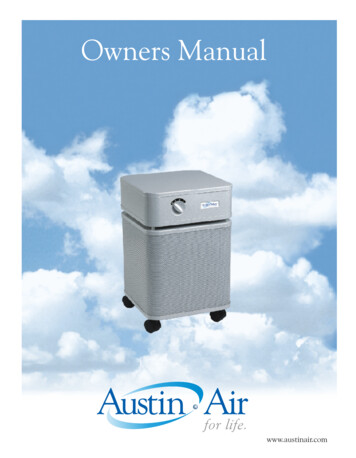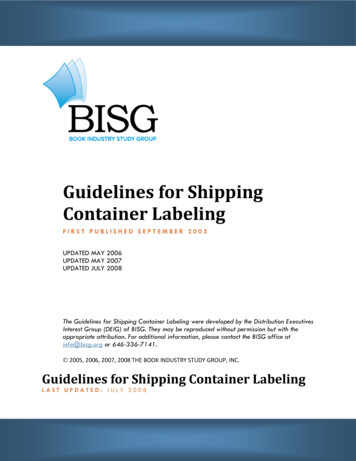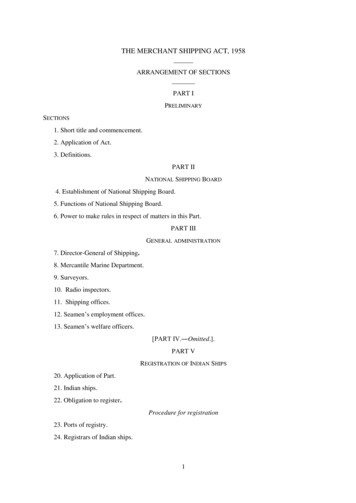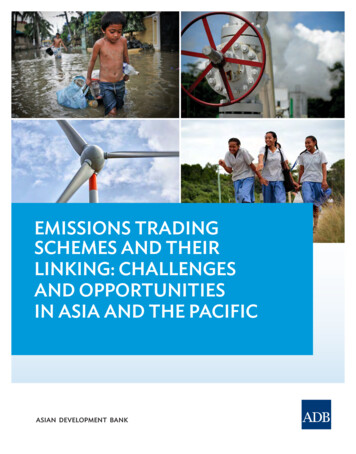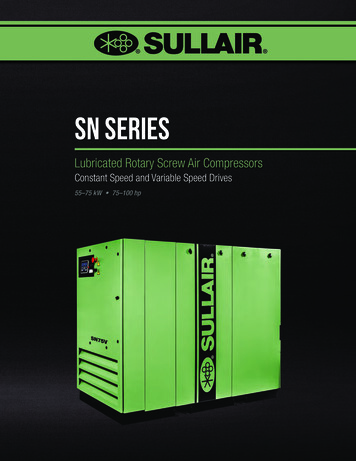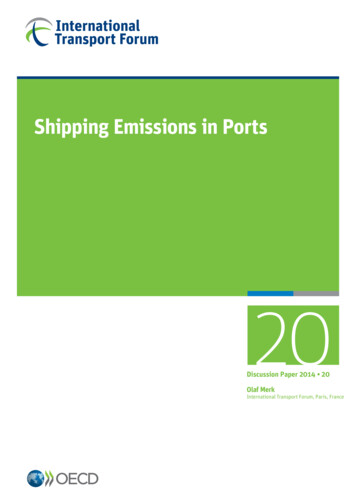
Transcription
Shipping Emissions in Ports20Discussion Paper 2014 20Olaf MerkInternational Transport Forum, Paris, France
Shipping Emissions in PortsDiscussion Paper No. 2014-20Olaf MERKInternational Transport Forum, Paris, FranceDecember 2014
THE INTERNATIONAL TRANSPORT FORUMThe International Transport Forum at the OECD is an intergovernmental organisation with54 member countries. It acts as a strategic think-tank, with the objective of helping shapethe transport policy agenda on a global level and ensuring that it contributes to economicgrowth, environmental protection, social inclusion and the preservation of human life andwell-being. The International Transport Forum organises an annual summit of Ministersalong with leading representatives from industry, civil society and academia.The International Transport Forum was created under a Declaration issued by the Councilof Ministers of the ECMT (European Conference of Ministers of Transport) at its MinisterialSession in May 2006 under the legal authority of the Protocol of the ECMT, signed inBrussels on 17 October 1953, and legal instruments of the OECD.The Members of the Forum are: Albania, Armenia, Australia, Austria, Azerbaijan, Belarus,Belgium, Bosnia and Herzegovina, Bulgaria, Canada, Chile, People’s Republic of China,Croatia, Czech Republic, Denmark, Estonia, Finland, France, Former Yugoslav Republic ofMacedonia, Georgia, Germany, Greece, Hungary, Iceland, India, Ireland, Italy, Japan, Korea,Latvia, Liechtenstein, Lithuania, Luxembourg, Malta, Mexico, Republic of Moldova,Montenegro, Netherlands, New Zealand, Norway, Poland, Portugal, Romania, RussianFederation, Serbia, Slovak Republic, Slovenia, Spain, Sweden, Switzerland, Turkey, Ukraine,United Kingdom and United States.The International Transport Forum’s Research Centre gathers statistics and conductsco-operative research programmes addressing all modes of transport. Its findings arewidely disseminated and support policymaking in Member countries as well as contributingto the annual summit.Discussion PapersThe International Transport Forum’s Discussion Paper Series makes economic research,commissioned or carried out at its Research Centre, available to researchers andpractitioners. The aim is to contribute to the understanding of the transport sector and toprovide inputs to transport policy design.ITF Discussion Papers should not be reported as representing the official views of the ITF orof its member countries. The opinions expressed and arguments employed are those of theauthors.Discussion Papers describe preliminary results or research in progress by the author(s) andare published to stimulate discussion on a broad range of issues on which the ITF works.Comments on Discussion Papers are welcomed, and may be sent to: International TransportForum/OECD, 2 rue André-Pascal, 75775 Paris Cedex 16, France.For further information on the Discussion Papers and other JTRC activities, please email:itf.contact@oecd.orgThe Discussion Papers can be downloaded ussionPapers/jtrcpapers.htmlThe International Transport Forum’s website is at: www.internationaltransportforum.orgThis document and any map included herein are without prejudice to the status of or sovereignty over any territory,to the delimitation of international frontiers and boundaries and to the name of any territory, city or area.
SHIPPING EMISSIONS IN PORTSTABLE OF CONTENTSEXECUTIVE SUMMARY . 41. INTRODUCTION . 52. LITERATURE REVIEW . 83. METHODOLOGY . 11i) Shore power facilities . 13ii) Emission control areas . 14iii) Other fuel switch programmes . 154. DATASET . 165. RESULTS . 175.1 Shipping emissions in ports in 2011 . 175.2 Estimated shipping emissions in ports in 2050 . 246. POLICY IMPLICATIONS . 26REFERENCES . 30TABLES1.Overview of studies on global shipping emissions . 62.Emission inventories of ports . 83.Academic studies on shipping emissions in ports . 94.Shipping emissions as share of total emissions in port-city . 105.Auxiliary Engine Emission Factors (g/kW-hr) . 136.Shore power facilities in ports in 2011 . 147.Emission control areas in force . 158.Allowed sulphur emissions inside and outside ECAs . 159.Voluntary Fuel switch programmes in ports in 2011 . 1610.Estimated shipping emissions in ports (2011) . 1711.Ports with the largest absolute emissions . 2012.Ports with the lowest relative emissions . 20FIGURES1.Ship types and their shares in emissions, port calls and port time (2011) . 182.Shipping emissions, port calls and port time per continent (2011) . 193.of CO2 emissions and ship calls . 214.Distribution of SOx emissions and ship calls . 225.Size distribution of CO2 emissions in 100 most active ports . 226.Size distribution of SOx emissions in 100 most active ports . 237.External costs of shipping emissions in top 50 OECD ports . 248.Increase in shipping emissions in ports 2011-2050 . 259.Shares of emissions and port calls, 2011 and 2050 . 25Olaf Merk — Discussion Paper 2014-20 — OECD/ITF 20143
SHIPPING EMISSIONS IN PORTSEXECUTIVE SUMMARYShipping emissions in ports are substantial, accounting for 18 million tonnes of CO2emissions, 0.4 million tonnes of NOx, 0.2 million of SOx and 0.03 million tonnes of PM10 in2011. Around 85% of emissions come from containerships and tankers. Containershipshave short port stays, but high emissions during these stays.Most of CO2 emissions in ports from shipping are in Asia and Europe (58%), but thisshare is low compared to their share of port calls (70%). European ports have much lessemissions of SOx (5%) and PM (7%) than their share of port calls (22%), which can beexplained by the EU regulation to use low sulphur fuels at berth.The ports with the largest absolute emission levels due to shipping are Singapore, HongKong (China), Tianjin (China) and Port Klang (Malaysia). The distribution of shippingemissions in ports is skewed: the ten ports with largest emissions represent 19% of totalCO2 emissions in ports and 22% of SOx emissions.The port with the lowest relative CO2 emissions (emissions per ship call) is Kitakyushu(Japan); the port of Kyllini (Greece) has the lowest SOx emissions. Other ports with lowrelative emissions come from Japan, Greece, UK, US and Sweden.Shipping emissions have considerable external costs in ports: almost EUR 12 billion peryear in the 50 largest ports in the OECD for NOx, SOx and PM emissions, the emissionsmost directly relevant to local populations. Approximately 230 million people are directlyexposed to the emissions in the top 100 world ports in terms of shipping emissions.Most shipping emissions in ports (CH4, CO, CO2 and NOx) are estimated to grow fourfoldup to 2050. This would bring CO2-emissions from ships in ports to approximately 70million tonnes in 2050 and NOx-emissions up to 1.3 million tonnes. Asia and Africa willsee the sharpest increases in emissions, due to strong port traffic growth and limitedmitigation measures.In order to reduce these projected emissions, strong policy responses will be needed.This could take the form of global regulation such as more stringent rules on sulphurcontent of ship fuel (such as the 0.5% sulphur cap already agreed by the IMO), or moreemission control areas than the four that are currently in place (which would extend the0.1% sulphur requirements to more areas). In addition, shipping could be included inmarket-based mechanisms for climate change mitigation.A lot could also be gained by policy initiatives of ports themselves. Various ports havedeveloped infrastructure, regulation and incentives that mitigate shipping emissions inports. These instruments would need wider application in order for ship emissions inports to be significantly reduced.4Olaf Merk — Discussion Paper 2014-20 — OECD/ITF 2014
SHIPPING EMISSIONS IN PORTS1. INTRODUCTIONShipping could – in one way - be considered a relatively clean transport mode. This isparticularly the case if one takes the angle of emissions per tonne-kilometre. Typicalranges of CO2 efficiencies of ships are between 0 and 60 grams per tonne-kilometre, thisrange is 20-120 for rail transport and 80-180 for road transport (IMO 2009). There isconsiderable variety between vessel types and CO2 efficiency generally increases withvessel size; e.g. CO2 emissions per tonne-km (in grams per year) for a container feedership (with capacity up to 500 TEU) were 31.6, three times higher than the emissions forPost Panamax container ships, with a capacity larger than 4,400 TEU (Psaraftis andKontovas, 2008). This difference is even larger for dry bulk ships, with a difference ofmore than a factor 10 between the smallest vessels (up to 5000 dwt) and capesizevessels ( 120,000 dwt).At the same time, the air emissions from shipping are considerable. Depending on themethodology, different studies have estimated CO2 emissions from shipping to be around2-3% of total global emissions and shares that are much higher for some of the non-GHGemissions: in the range of 5-10% for SOx emissions and 17-31% for NOx emissions(Table 1). A solid body of research exist on shipping emissions in particular parts of theworld (e.g. Europe) that confirm the reliability of these shares of shipping emissions (e.g.Cofala et al. 2007).In comparison with other transport modes, shipping emissions are also substantial.Whereas CO2 emissions of shipping might be approximately a fifth of those of roadtransport, NOx and PM emissions are almost on a par, and SOx emissions of shipping aresubstantially higher than those of road transport by a factor of 1.6 to 2.7 (ICCT, 2007).According to Eyring et al. (2003) international shipping produces about 9.2 more NOxemissions than aviation, approximately 80 times more SOx emissions and around 1200times more particulate matter than aviation, due to the high sulphur content in ship fuel.These emissions have increased at a large pace over the last decades and are expectedto increase in the future. Eyring et al. (2003) show that main shipping emissions (CO2,SOx, NOx and PM) grew with a factor of approximately 4 over the period 1950-2001,faster than the increase of the number of ships over that period, which tripled. Shippingemissions are projected to increase over the coming decades. E.g. the IMO assumed in2014 that shipping-related carbon dioxide emissions would increase with a factor two tothree up till 2050 (IMO, 2014).Although most of these emissions take place at sea, the most directly noticeable part ofshipping emissions takes place in port areas and port-cities. It is here that shippingemissions have the most direct health impacts. NO2 and CO-emissions in ports have beenlinked to bronchitic symptoms, whereas exposure to SO2-emissions is associated withrespiratory issues and premature births. Data from the Los Angeles County HealthSurvey reveal that Long Beach communities in close proximity to the Port of Los Angelesexperience higher rates (2.9 percentage points on average) of asthma, coronary heartdisease and depression, compared to other communities in Los Angeles (Human ImpactPartners, 2010). Additionally, the California Air Resources Board attributed 3 700Olaf Merk — Discussion Paper 2014-20 — OECD/ITF 20145
SHIPPING EMISSIONS IN PORTSpremature deaths per year to ports and the shipment of goods (Sharma, 2006). On aglobal scale, calculations suggest that shipping-related PM emissions are responsible forapproximately 60,000 cardiopulmonary and lung cancer deaths annually, with mostdeaths occurring near coastlines in Europe, East Asia and South Asia (Corbett, 2007).Table 1. Overview of studies on global shipping emissionsCO2SOxNOxPM10Estimation(mln 520122007200520012001200020122007200120012000Share of 17%-SourceIMO 2014IMO 2009Psaraftis & Kontovas 2009Paxian et al. 2010Eyring et al. 2005Corbett & Koehler 2003Endresen et al. 2003IMO 2000IMO 2014IMO 2009ICCT 2007Eyring et al. 2005Corbett & Koehler 2003Endresen et al. 2003Cofala et al. 2007IMO 2014IMO 2009ICCT 2007Cofala et al. 2007Eyring et al. 2005Corbett & Koehler 2003Endresen et al. 2003IMO 2014IMO 2009Cofala et al. 2007Eyring et al. 2005Corbett & Koehler 2003Endresen et al. 2003Source: own data collectionHowever, relatively little is known about ship emissions in ports. The literature reviewbelow (section 2) identifies the main studies in this respect, which in most cases are casestudies of one port. What is missing is a comprehensive overview of shipping emissionsin ports, using a uniform definition and methodology, so that emissions in different portscan be compared with each other. This paper wants to fill this gap, by providing thiscomprehensive overview of shipping emissions in ports. It considers the following airemissions: CH4, CO, CO2, NOx, PM10, PM2,5 and SOx. The calculation of shipping emissionsin ports makes use of a database of Lloyd’s Marine Intelligence Unit on vesselmovements in 2011, containing information on turnaround times of ships in ports acrossthe world and ship characteristics, which allows for a bottom-up estimation of shipemissions during port calls. In these calculations, various policy measures implementedin ports to mitigate air emissions have been taken into account, such as the EUregulation to use low sulphur fuel at berth, shore power and various fuel switchprogrammes. The analysis has been made for different ship types, including6Olaf Merk — Discussion Paper 2014-20 — OECD/ITF 2014
SHIPPING EMISSIONS IN PORTScontainerships, bulk carriers, tankers and Roll on/Roll off- (Ro/Ro-) ships, carrying avariety of cargo categories. This calculation has been aggregated into emissions per portand per country in 2011. Projections have been made towards 2050, based on the ITFFreight projection model. These projections have been made per country.Olaf Merk — Discussion Paper 2014-20 — OECD/ITF 20147
SHIPPING EMISSIONS IN PORTS2. LITERATURE REVIEWThere is a limited number of studies on global shipping emissions which containestimations on the in-port emissions, that is ship emissions in ports. The two examples ofthese studies are Entec (2002) and Dalsoren et al (2008). The Entec-study (2002)estimates emissions from ships associated with movements between ports in Europeancountries; as they assign ship emissions to 50 km by 50 km grid squares the ship-relatedemissions in port areas are made visible. The paper of Dalsøren et al. (2008) uses anapproximation of port time to calculate the in-port shipping emissions, but does not givedetails on individual ports, except for Singapore. Although these studies certainly havetheir merits with regards to calculation of ship emissions in ports, they both suffer fromrelatively inexact data or assumptions on the time that ships spent in a port. The Entecstudy uses port time data based on a questionnaire survey of ports; and although theDalsøren et al. paper is more accurate in that it takes actual time in ports, it cannot bevery precise because the dataset measures port time in days and not in hours, let aloneminutes.Ports also increasingly measure emissions in port areas themselves via emissioninventories (Table 2), but it is not always easy to separate the effects of shipping, portoperations, hinterland transport and industrial development on the port site.Table 2. Emission inventories of portsPortLos AngelesLong BeachSeattleNew YorkNew JerseyOaklandVancouverShanghaiGothenburg8-Main indicatorsPort-related GHG emissions (electric wharf cranes, building electricity, building naturalgas, port employee vehicles, expanded GHG inventory)Diesel particulate matter (DPM), nitrogen oxides (NOx), SOx, CO2e emissions by sourcecategory: Ocean-going vessels (OGV), harbour craft (HC), cargo-handling equipment(CHE), heavy-duty vehicles (HDV), rail locomotives (RL).Containerised cargo volume trendPort DPM, NOx, SOx, CO2e emissions trendPort-related emissions (PM10, PM2.5, DPM, NOx, SOx, carbon monoxide (CO), HC) bycategory: OGV, HC, CHE, RL, HDV.Port-related GHG emissions (CO2E, CO2, N2O, CH4) by category: OGV, HC, CHE, RL,HDV.Total airshed emissions (NOx, VOC, CO, SO2, PM10, PM2.5, DPM, CO2e) by sourcecategory: OGV, harbour vessels, RL, CHE, HDV, fleet vehiclesGHG emissions (CO2, CH4, N2O, HFCs, PFCs, SF6) by the category “Port Commerce”(commercial marine vessels, CHE, RL, HDV, buildings, landfill, fleet vehicles)Port commerce emission per TEU handledTotal Criteria Air Pollutant (CAP) emission (NOx, NO2, PM)Particulate Matter (PM, including diesel), NOx, SO2, Reactive Organic Gas (RO), and COemissions by source category: ships, HC, CHE, RL, trucks.Common Air Contaminants (CACs): NOx, SOx, CO, VOCs, PM10, PM2.5, NH3, GHGs – CO2,CH4, N2O by source group (administration, CHE, on road, rail).Air pollutant emissions (NOx, SO2, PM, VOC, CO) of ships (ships of international shippinglines, ships registered at ports and managed by local maritime authorities, shipstravelling along the coast, hotelling, internal rivers).GHG emissions by:*Direct emissions: operational vessels, operational vehicles, heating buildings (by fuelusage), fire equipment*Energy indirect emissions: electricity usage, direct heating*Other indirect emissions: business flights gallons per annum, business travel by carSince2001200220062005200520062010Olaf Merk — Discussion Paper 2014-20 — OECD/ITF 2014
SHIPPING EMISSIONS IN ns per annum, terminals, vessels at the quay/ traffic area, loading of gasoline,leakage of pipelines, carpoolAir emissions at Darsena Sud and Port Vell: SO2, H2S, NO2, C6H6, PM10.Direct CO2 emissionsIndirect CO2 emissionsCO2 emissions by equipment type: straddle carriers, OGVs, container/ rail gantrycranes, reefer containers, storage cranesMaritime related emissions (NOx, VOC, CO, SO2, PM10, PM2.5, CO2) by source category:OGV, heavy-duty diesel-fuelled vehicles, CHE RL, harbour vesselsCO2 emissions by activity: commercial vessels, cargo handling & Tenants, rail, roadNitrogen dioxide concentrations, monthly averageSulphur dioxide concentrations, monthly averageVessel waste waters received by Port of HelsinkiVessel waste waters pumped into sewage systems in Helsinki20042011200720112010Source: Own data collection based on information provided by port authorities.In addition, there is a considerable amount of case studies of ports and port-cities thatcalculate the shipping-related emissions on the area. These studies apply a variety ofdifferent methodologies and definitions, as can be illustrated by Table 3 below, theoutcomes of these studies are difficult to compare with each other (Mueller et al. 2011).Main differences in method are between calculations based on fuel consumption andactivity based; the last type of studies takes into account the activity of the ship (such asthe hours spent cruising, manoeuvring and hotelling), whereas the first approach islooking at fuel accounts of ships to estimate emissions. The focus of the estimationsdiffers with respect to geographical demarcations (only port area, or also territorialwaters), with respect to the ships included (only ocean-going vessels, or also port vessels(such as tugs) and inland river vessels), and with respect to other port activitiesincluded, such as other transport modes within the port (port trucks and locomotives)and cargo handling equipment, such as cranes and other equipment.For this paper, we prepared a database with the main findings of these studies, modifiedin such a way that it allows for comparison. For this purpose, we took only the shippingemissions in ports into account for ocean going vessels at berth in hotelling andmanoeuvring mode. We did not include other vessels, nor equipment, nor port trucks andlocomotives.Table 3. Academic studies on shipping emissions in portsPortHong Kong (China)Hong Kong (China)Shanghai (China)Yangshan (China)Busan (Korea)Busan (Korea)Incheon (Korea)Kaohsiung (Tapei)Kaohsiung (Tapei)Klaipeda (Lithuania)Taranto (Italy)Ravenna (Italy)Venice, Piombino (Italy)Venice (Italy)Brindisi (Italy)Ambarli (Turkey)Izmir (Turkey)Barcelona (Spain)Piraeus (Greece)MethodActivity based (AIS)Activity based (AIS)Activity basedActivity-based (AIS)Activity basedActivity basedActivity basedActivity basedCargo capacity, activitytimeActivity based (LMIU)Air quality measurementFuel consumptionFuel consumptionAir quality measurementActivity basedActivity basedActivity basedFuel based & activity basedEmissions of:OGVs in territorial watersOGVs in territorial watersOGV and inland bargesVessels in port areaVessels in port areaVessels, equipment, port trucks, trainsVessels, equipment, port trucks, trainsVessels and trucks in port areaMerchant vesselsSourceYau et al. 2012Ng et al. 2013Yang et al. 2007Song 2014Song & Shon 2014Shin & Cheong 2011Han et al. 2011Berechman & Tseng 2012Liu et al. 2014Marine shipsShipping, industry and urban trafficVessels in port areaMarine ships in port areaVessels in port areaVessels and port equipmentVessels in port areaVessels in port areaVessels, electricity, heating, cargohandling, vehicles, trucks, wasteVessels in port areaAbrutyte et al. 2014Gariazzo et al. 2007Lucialli et al. 2007Trozzi et al. 1996Contini et al. 2011Donateo et al. 2014Deniz & Kilic 2009Saraçoglu et al. 2013Villalba&Gemechu 2011Olaf Merk — Discussion Paper 2014-20 — OECD/ITF 2014Tzanattos 2010a9
SHIPPING EMISSIONS IN PORTSVictoria, BC (Canada)Göteborg (Sweden)Copenhagen (Denmark)Mumbai (India)Aberdeen (UK)13 main Spanish portsAir quality measurementAir quality measurementAir quality measurementActivity basedAir quality surveyActivity basedCruise shipsShips entering the inner part of portVessels in portsOGVs in port areaShips and trucks in the port areaVessels manoeuvring and hotellingRotterdam (Netherlands)Fuel consumptionShips at berthPoplawski et al. 2011Isakson et al. 2001Saxe & Larsen 2004Joseph et al. 2009Marr et al. 2007Castells Sanabra et al.2014Hulskotte & Denier vander Gon, 2010Source: Own data collection.The largest part of emissions in ports is generally from shipping activity; this can beconcluded from this collection of studies on emissions in ports. Between 70% to 100% ofemissions in ports in developed countries can be attributed to shipping; trucks andlocomotives represent up one fifth, whereas emissions from equipment rarely exceed15%. The picture is different for ports in developing countries where regulations on truckfuels are less strict and where a larger share of the total emssions in ports is taken up bytrucks and locomotives. E.g. in the port of Mumbai, the NOx emissions from port trucksare almost 20% higher than those from ships; and PM10 emissions from trucks are 26times higher than from ships (Joseph et al. 2009).Shipping emissions in ports can represent a substantial share of total emissions in theport-city. Much depends on the size of the port, the size of the city and the character ofthe city, such as industrialisation rate. In some large port-cities, such as Hong Kong andLos Angeles/Long Beach, the share of SO2 emissions can reach half of the total emissionsin the city; for NOx and particulate matter emission levels that represent up to a fifth oftotal urban emission are not rare (Table 4).Table 4. Shipping emissions as share of total emissions in port-cityPortHong KongShanghaiLos Angeles/Long BeachRotterdamKaohsiungHong KongTarantoIzmirVeniceBrindisiLos Angeles/Long %8%8%-SourceCivic Exchange 2009Hong et al. 2013Starcrest 2011Merk 2013Liu et al. 2014Yau et al. 2012Gariazzo et al 2007Saraçoglu et al. 2013Contini et al. 2010Di Sabatino et al. 2012Agrawal et al. 2009Viana et al. 2009Pandolfi et al. 2011Source: Own data collection.The approach in this paper is to provide a comparative overview of shipping emissions inports. This makes it possible to compare the different emissions in port-cities and gobeyond the incidental case studies whose values are difficult to compare to each other. Atthe same time, it also refines the literature on global shipping emissions in ports by usinga more precise dataset on time spent in ports.10Olaf Merk — Discussion Paper 2014-20 — OECD/ITF 2014
SHIPPING EMISSIONS IN PORTS3. METHODOLOGYSeveral methodologies have been used to estimate emissions from shipping, which canbasically be summarized in four models, depending on whether emission evaluation istop-down or bottom up, and whether the geographical characterisation of emissions istop-down or bottom-up (Miola and Ciuffo, 2011): In a full top-down approach, total emissions are calculated without considering thevessel characteristics and are after the calculation geographically located andassigned to the different ships. The first studies on ship emissions took thisapproach and used international marine fuel usage statistics to estimate shipemissions, but results from this approach were later considered to be unreliable. In the second approach, a full bottom up approach, air pollutants emitted by aship in a specific position are calculated; aggregating these estimates over timeand over the fleet gives an estimation of the total emissions. This approach can beconsidered much more reliable, but the data required for such an approach haveonly recently come available, so for the moment there is a limited amount ofstudies using this approach. As a result, a considerable amount of studies takeapproaches that are more hybrid. There is a model that is bottom up in the evaluations of total emissions and topdown in their geographical characterisation. In this approach, the aggregation ofthe emissions produced by all the ships gives an estimate of the total emissions;the emissions are then geographically characterised based on assumptions, e.g.ship activities or single geographic cells. A fairly recent approach is to useAutomatic Identification System (AIS) data to refine the maritime data. The fourth approach is top down in the evaluation of total emissions plus bottomup in the geographic characterisation. In this approach the global activity carriedout within a single maritime route or a single geographic cell is evaluated.Emissions from individual cells are aggregated to calculate total emissions andassumptions are made in order to assign total emissions to the different ships.Our approach here is to use a bottom up-approach with respect to both shipcharacteristics (horsepower of the engines) and geographical characterisation, that is:the actual time spent in ports (in hours and minutes) by vessels. Following Joseph et al.(2009), the following equation is used to estimate shipping-related emissions at ports:E P*LF*EF*TWhere:Eemissions in units of pollutantPmaximum power output of auxiliary engine in kWLFload factor for auxiliary engines, as a fraction of maximum installed powercapacityEFemission factor (pollutant specific) in mass emitted per work output of theauxiliary engine in manoeuvring and hotelling mode, g/kWh andTtime in manoeuvring and hotelling mode in hoursOlaf Merk — Discussion Paper 2014-20 — OECD/ITF 201411
SHIPPING EMISSIONS IN PORTSThe principle behind this equation is to apply emission factors to activity rates, asgenerally the case when estimating emissions. The activity rate of the individual vesselsin our database is estimated using rules of thumb indicated and explained below. Shipsuse auxiliary power whilst being at berth. The maximum power of auxiliary engines in avessel is estimated based on auxiliary engine power ratios and an estimation of a vessel’smain engine horsepower as a function of dead weight tonnage.We have made calculations for four different ship categories: Container ships (fully cellular containerships).Tankers (including crude oil tankers, chemical tankers, combined tankers andproduct tankers).Bulk carriers.Roll on/Roll off- (Ro/Ro)-shi
Shipping emissions in ports are substantial, accounting for 18 million tonnes of CO 2 emissions, 0.4 million tonnes of NO x, 0.2 million of SO x and 0.03 million tonnes of PM 10 in 2011. Around 85% of emissions come from containerships and tankers. Containerships have short port stays, but high emissions during these stays. Most of CO 2



